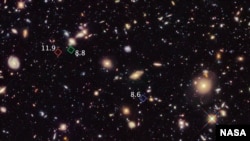“Green pea” galaxies, which are small, round and green, may shed light on the formation of the early universe, according to a new study.
Writing in the journal Nature, a research team says green pea galaxies, which were discovered in 2007, “were likely the reason that the universe heated up about 13 billion years ago.”
Several hundred thousand years after the Big Bang, the universe was very hot and dense, which caused matter to become ionized. About 380,000 years later, the universe cooled enough for matter to neutralize, leading to the formation of gas clouds of hydrogen and helium. These grew and eventually collapsed into the first stars and galaxies.
Then, the universe got hot again.
The reheating is key, because it led to the reionization of hydrogen about 13 billion years ago, just a billion years after the Big Bang. Why this happened is debated, but astronomers have long believed early galaxies caused the reheating.
The team used data from the Hubble Space Telescope’s ultraviolet spectrometer to examine five relatively nearby green pea galaxies that are emitting a large quantity of ionizing photons into the intergalactic medium, or the space between galaxies. These photons are believed to be the reason for the reionization of the universe.
One galaxy, J0925+1403, which is 3 billion light-years away, had a particularly intense ejection of ionizing photons. This, researchers said, could explain “cosmic reionization”
"This galaxy appears to be an excellent local analog of the numerous dwarf galaxies thought to be responsible for the reionization of the early universe," said University of Virginia astronomer Trinh Thuan. "The finding is significant because it gives us a good place to look for probing the reionization phenomenon, which took place early in the formation of the universe that became the universe we have today."
More observations needed
But researchers say they need to keep looking at green pea galaxies to confirm their findings.
"As we make additional observations using Hubble, we expect to gain a much better understanding of the way photons are ejected from this type of galaxy, and the specific galaxy types driving cosmic reionization," Trinh said.
"These are crucial observations in the process of stepping back in time to the early universe," Trinh said. "They paved the way to future observations with the successor of Hubble, the James Webb Space Telescope, planned for launch in 2018, which is expected to revolutionize the field with updated capabilities for detailing the first galaxies and sources of cosmic reionization."
In a column that accompanied the study, University of Wisconsin-Milwaukee researcher Dawn Erb said the study “broadly confirms our understanding of the general conditions that may facilitate the escape of ionizing radiation.”
She added further study is needed.
“It is not yet clear whether or not J0925+1403 is typical of compact, highly ionized starbursts (galaxies with extremely high rates of star formation) in the nearby universe,” she wrote.
“We also do not know whether this galaxy is similar to those that reionized the universe; its small size, high ionization state and relatively low degree of enrichment by elements heavier than helium generally match the expected properties of such objects, but none of these properties has been measured for the earliest galaxies," Erb wrote.















